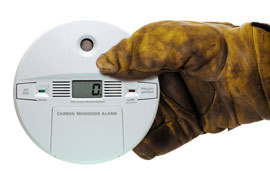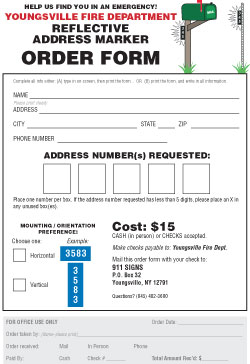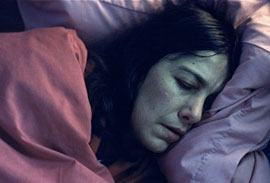Carbon Monoxide Detectors - it's the Law!
 Amanda’s Law, passed in the 2009 Session of the New York State Legislature, establishes a new requirement for installation of carbon monoxide detectors in homes. This new law took effect on February 22, 2010. The law was named after Amanda Hansen, a teenager whose life was tragically ended by
a carbon monoxide leak from a defective boiler while she was sleeping at a friend’s
house in January 2009.
Amanda’s Law, passed in the 2009 Session of the New York State Legislature, establishes a new requirement for installation of carbon monoxide detectors in homes. This new law took effect on February 22, 2010. The law was named after Amanda Hansen, a teenager whose life was tragically ended by
a carbon monoxide leak from a defective boiler while she was sleeping at a friend’s
house in January 2009.
Under the law, one-family homes, two-family homes, dwellings located in condominiums or cooperatives, and multiple dwellings must have a carbon monoxide detector installed regardless of the date of construction or sale.
The new law also requires that the carbon monoxide detector you use must be a device meeting New York State standards, and that it be installed in an operable condition in dwellings where there are appliances or systems that may emit carbon monoxide or if there's an attached garage.
As a result of Amanda’s Law, a carbon monoxide detector will be found in nearly all residential structures in the state. This creates a safer living environment for New York residents and creates a greater awareness of home safety issues that are intensified by seasonal heating issues prevalent in the Northeast.
Help Us Find Your Home in an Emergency
 Don't let emergency vehicles waste precious time trying to find your home after dark. We need to see your address as we approach your driveway, and it's important that your address numbers are clearly visible and HIGHLY REFLECTIVE.
Don't let emergency vehicles waste precious time trying to find your home after dark. We need to see your address as we approach your driveway, and it's important that your address numbers are clearly visible and HIGHLY REFLECTIVE.
We recommend you use these 4-inch tall, blue-and-white highly reflective numbers so we can see and read your address easily. The cost is only $15 (for up to 5 numbers). Click on the order form graphic at left to open the form. Then fill in your information on-screen and print it, OR print the form and then fill in the blanks with pen/ink. Please print clearly. Mail the form with your check, or bring your completed form to the firehouse with cash or check. Please do not mail cash!
Mail to:
Youngsville Fire Department
1822 Shandelee Road
Youngsville, NY 12791
You'll receive your reflective address numbers in the mail within two weeks. Then attach the numbers horizontally on your mailbox, or vertically on your mailbox post or a metal stake near your driveway. Four feet or so off the ground is ideal. Keep plants/flowers in summer, and snow in winter cleared away from your address numbers so emergency personnel can see them year round. We appreciate your cooperation!
Questions? Call us at (845) 482-3600.
WATER SAFETY TIPS - read this!
Did you know that about 6,000 people per year drown in the United States? But what is most shocking is that two-thirds of those drowning victims never intended to be in the water! Things can happen quickly. Don't become a drowning statistic -- always wear a life jacket or PSD (personal floatation device) whenever you are around water.
BASIC WATER SAFETY: Because most drowning victims had no intention of getting in the water, and most people drown within 10 to 30 feet of safety, it is important that you and your family LEARN TO SWIM.
- Always wear a life jacket when you are on or around the water!
- Never rely on toys such as inner tubes and water wings to stay afloat.
- Don't take any chances by overestimating your swimming skills.
- Swim only in designated swimming areas.
- Never swim alone.
NEVER DIVE INTO LAKES OR RIVERS. Every year, more than 8,000 people have diving accidents and suffer paralyzing spinal cord injuries – and another 5,000 die before they reach the hospital.
WATCH SMALL CHILDREN: Each year about 200 children drown and several thousand others are treated in hospitals for submersion accidents, accidents which leave children with permanent brain damage and respiratory health problems. Remember, it only takes a few seconds for a small child to wander away. So please watch your children at all times.
ALCOHOL: THE FUN KILLER: It's a fact, alcohol and being in or on the water don't mix. Unfortunately many people ignore this and each year about 3,000 of them are wrong...dead wrong! More than half of all the people that drown had consumed alcohol prior to their accident.
Being intoxicated is not necessary for alcohol to be a threat to your safety. Just one beer will impair your balance, vision, judgment, and reaction time, thus making you a potential danger to yourself and others.
Research shows that after just four hours of boating (exposure to noise, vibration, sun, glare and wind), you can experience "boating fatigue" which slows your response to emergency situations. If you actually add alcohol to the boating fatigue condition, it intensifies the effects and increases your accident risk! So remember, don't drink alcohol if you are planning to be in or on the water!
COLD WATER SURVIVAL: Your life may depend on a better understanding of cold water. It's a fact that many drowning victims actually die from cold exposure or hypothermia. Hypothermia is a condition in which the body loses heat faster than it can produce it. Violent shivering develops which may result in confusion and a loss of body movement.
To avoid hypothermia:
- Dress warmly with wool clothing.
- Wear rain gear and stay dry.
- Seek a warm environment at the first sign (mild shivering) of hypothermia.
- If you fall in the water, don't discard your clothing.
- While wearing your life jacket, draw your knees and arms together into the HELP (Heat Escape Lessening Posture) posture.
THE FOUR MAJOR CAUSES OF DROWNINGS ARE:
- Not wearing life jacket
- Abuse of alcohol on or near the water
- Lack of sufficient swimming skills
- Hypothermia
 Symptoms of carbon monoxide poisoning include headaches, drowsiness, dizziness, nausea and convulsions. Because carbon monoxide is hard to detect, someone with mild poisoning can go to sleep and continue to breathe the carbon monoxide until severe illness or death occurs. People may also mistake their symptoms for a viral infection like the flu. Don't take chances with your life and with the lives of others.
Symptoms of carbon monoxide poisoning include headaches, drowsiness, dizziness, nausea and convulsions. Because carbon monoxide is hard to detect, someone with mild poisoning can go to sleep and continue to breathe the carbon monoxide until severe illness or death occurs. People may also mistake their symptoms for a viral infection like the flu. Don't take chances with your life and with the lives of others.